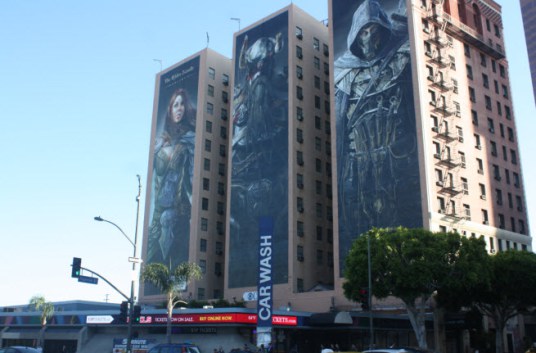The orgy of games is approaching. OK, the organizers of the Electronic Entertainment Expo (E3) don’t call it that. But that’s what it is. The video game industry is expecting to draw 45,000 to 50,000 professionals and journalists to the Los Angeles Convention Center starting on June 9.
 Although the game industry is in turmoil, the show is expecting to attract more than 200 exhibitors to more than 350,000 square feet of space, or more than eight football fields. Thousands of media and bloggers will appear, helping to provide more than 25 billion consumer media impressions during the event.
Although the game industry is in turmoil, the show is expecting to attract more than 200 exhibitors to more than 350,000 square feet of space, or more than eight football fields. Thousands of media and bloggers will appear, helping to provide more than 25 billion consumer media impressions during the event.
“We’re hardwired to be excited around here,” said Mike Gallagher (pictured), the president and chief executive of the Entertainment Software Association (ESA), the trade group for video game companies and the producer of the show, in an interview with GamesBeat. “The eyes of the world are going to be upon us.”
We think of Gallagher as the game industry’s biggest suit. When it needs better PR, Gallagher has to step up. He has to take to the microphones when angry politicians call for antiviolent game legislation. He delivers the bright and happy message about industry growth even as companies scramble to balance the decline of traditional games with the rise of digital ones. And he has to embrace all of gaming across all platforms even though he would really like to go off in a corner and play a game.
That’s a heavy responsibility, but it’s not such a bad job. This year is going to be more fun because Microsoft will show up with the Xbox One console, its first new machine in eight years, and Sony will come with the PlayStation 4, its first in seven years. Nintendo launched its Wii U console last fall and will show off games that it hopes will keep its ecosystem competitive.
All three of these machines will be a “tremendous shot in the arm for the industry,” Gallagher said. “They represent the best in risk-taking nature for our industry … . By comparison, other entertainment industries seem like they are standing still.”
The excitement over the new machines is palpable as there is a lot of pent-up demand, he said.
“The console makers will be in full competition, and their machines will be fully playable at E3,” Gallagher said. “This is the place to show the world what is coming next.”
Apple won’t be there, as it has never participated in E3 despite the disruption it has caused with free or 99-cent games on its smartphones and tablets. Gallagher says Apple is always invited but chooses to go its own way. The same goes for the more controversial Rockstar Games, which is debuting another Grand Theft Auto game this year — but not at E3.
Gallagher says cryptically, “I’m sure we’ll see some surprises.”
Creative destruction
Gallagher says the game industry can absorb disruption. Big publishers such as THQ have faltered. But the bankrupt company auctioned off its games, and those titles are showing up in the booths of other publishers this year. And while some companies such as 2K Games have chosen not to exhibit, Gallagher says you will see all of the companies that “drive the growth of the industry.”
New this year will be a mobile pavilion, where mobile-game startups can show off their wares.
“That is a packed house,” Gallagher said.
Mobile gaming has taken off like a rocket in the past year. Supercell, a Finnish company that made Clash of Clans and Hay Day, raised $130 million at a $770 million valuation last month. And Gung Ho Entertainment, a Japanese gamemaker that created the quirky Puzzle & Dragons title, is making more than $3 million a day from its game. It may very well have the first billion-dollar mobile game on its hands if the trends hold steady. And within mobile, games were 24 of the top 25 apps in the App Store, and they generated more than 50 percent of the revenue on Apple’s platform.
 You’ll also see PC game companies that are touting free-to-play titles, such as Wargaming.net, which will have a huge booth to show off games like World of Tanks and World of Warplanes. And foreign companies such as Nexon are coming to the show even though they are 100 percent digital and have no need to snag the attention of retail game buyers. The sales of these digital companies aren’t captured in the monthly retail stats collected by market researcher NPD, and so it seems like game companies are shrinking rather than expanding, Gallagher said.
You’ll also see PC game companies that are touting free-to-play titles, such as Wargaming.net, which will have a huge booth to show off games like World of Tanks and World of Warplanes. And foreign companies such as Nexon are coming to the show even though they are 100 percent digital and have no need to snag the attention of retail game buyers. The sales of these digital companies aren’t captured in the monthly retail stats collected by market researcher NPD, and so it seems like game companies are shrinking rather than expanding, Gallagher said.
“Some are contracting, and others are expanding,” Gallagher said. “That is the nature of the show.”
Not on the defensive
Gallagher said he is proud of how the game industry reacted to the outrage over the massacre of children in Newtown, Conn. He said it stepped up to participate in the national conversation that happened in the wake of the shooting and the National Rifle Association’s pinning the blame on violent video games. The industry met with the White House, the vice president, and many other politicians to engage in a “dialogue for the path that lies ahead.”
“Some expressed concern about the industry, and most have said they want our help,” he said.
He said the game industry reaches scores of millions of people a day and has a unique ability to communicate with the American people in a responsible and mature way.
“That’s a recognition of the strength of the industry, and at this point, the industry is in a very strong position,” Gallagher said.

